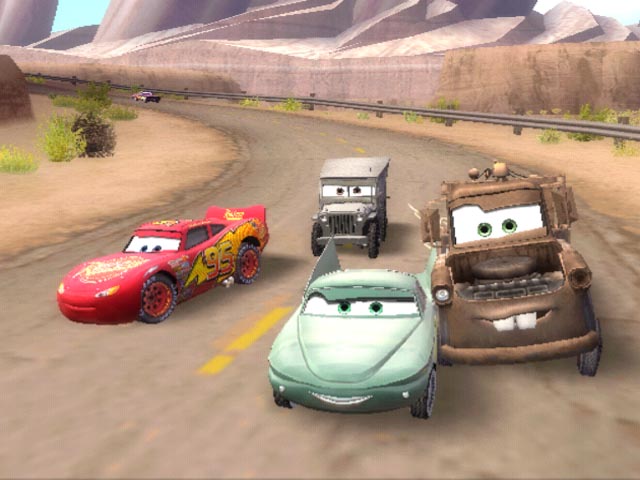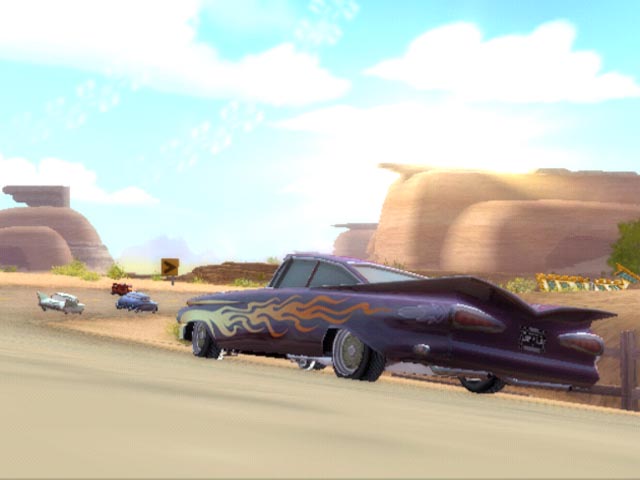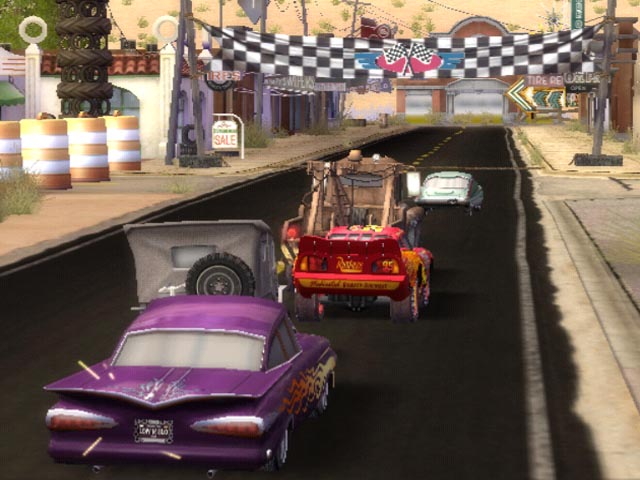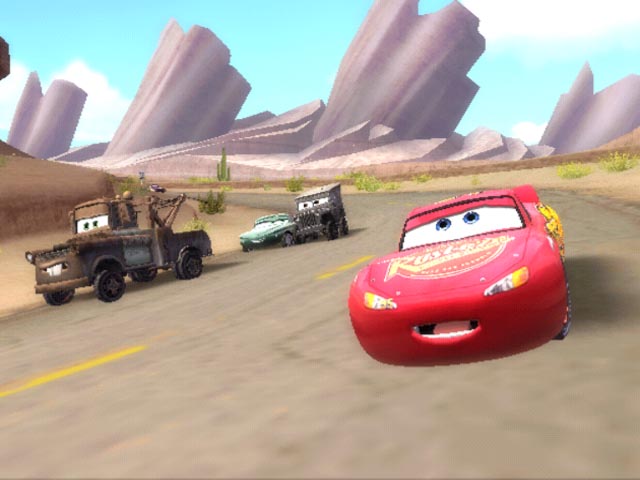Ahoy, squirts! Quint here to present the newest Games Column and Monki's email interview with Jordan Itkowitz, who steered the talented Rainbow Studios team to create the CARS video game.
The movie was a ton of fun and I'm sure the kiddies will love playing these characters at home. And from what Jordan says in the interview I'd imagine he'd be of like minds with me, especially at his suggestion of bringing Jack Burton to the console. What a day that'd be... it'd shake the pillars of heaven... Anyway, here's Monki and some screen caps! Enjoy!
Hey there folks, Monki here again with another great interview for the upcoming release of Cars, the movie-based game. I talked with Jordan Itkowitz, the lead game designer on the project and got some great information on the game including a sweet little bonus at the end.

Monki: What kind of game is this going to be? Is it pure racing or is it a story driven game?
Jordan: Both, actually - we’re calling it a “racing adventure.”
Obviously it was going to be racing of some kind - they’re cars, after all. Also, this is Rainbow Studios - racing is what we’re known for. We didn’t just want to do a linear progression of tracks, though, or limit it to racing only - Pixar’s created such a rich world with Radiator Springs/Ornament Valley, and we felt it’d be great for the audience to explore that world, to immerse players in it and let them experience it beyond the two hours they’ll have in the theaters.
So the core of the game is a full story experience set in a vast open world, from which you access road races, mini-games, and the big Piston Cup races which serve as our chapter finales. Explore memorable parts of Radiator Springs, Ornament Valley and Tailfin Pass, and find some brand new areas of the world too. You’ll see all of the characters from the film, including some new ones as well. And it’s all tied together by over a half-hour of original cut scenes. The storyline actually takes place after the events of the movie - it folds in a lot of the key moments you’ll remember from the movie, and presents them alongside a lot of new ones.
Monki: How was the movie crew involved in the production of the game? I know John Lasseter was very detail-driven on the movie due to his love of cars, did he help out with the game a lot?
Jordan: Pixar and Disney were very involved, which as you can guess, made this game such a pleasure to work on.
Our shared goal was to make the game as 1:1 with the movie as possible, and so Pixar furnished us with mountains of reference and concept art. Our artists had access to the lighting, environment and texture artists to nail the visuals. Our animators had frequent check-ins and shadow meetings with their animators, to ensure that our in-game characters moved and performed as you’d expect them to. Cut scenes went through a thorough process of feedback and approval as we worked with the DP and layout artists to match camera angles and composition. And of course, we saw the movie many times during development, even back when it was just boards and a scratch track - I haven’t even seen the final print yet, so I’m just as excited for June 9th as you guys are.
Working with John was certainly one of my favorite parts of the process. We had a few meetings with him during production, and each time, the meetings went way over their allotted time because he was so enthusiastic about the game - he saw it as a great way to expand the Cars universe.
In addition to riffs and guidance for the overall design and presentation, John also came up with a number of events which we put into the game - things like the Rustbucket Race-o-Rama, a demolition derby where Mater races against his hillbilly junker cousins. John also showed us sketches for Count Spatula, a monster truck who’d appeared in an early version of the film. John, Joe Ranft (co-director; head of story) and Steve Purcell (story artist) quickly whipped up a scenario where Lightning is challenged by Count Spatula and his monster truck gang, who were designed later on (The Crippler, a maniacal ambulance, and Ginormous, who’s just big and dumb, kinda the Non to Spatula’s Zod). Lightning runs to Luigi’s, gets outfitted with huge tires, and then you’re off to the Rustbucket stadium again for another event.
We have 14 new characters for the game from Pixar - in addition to the Monster Trucks and Mater’s cousins, there’s a pair of British gentleman racers (also from an early version of the film), a gang of disco-lovin’ muscle cars from Jersey, and a couple of pimped-out low-riders. Developing these characters from the tires up, and then coming up with their personalities, going through the entire dialogue process with story, casting and recording them - it was a terrific window into Pixar’s creative process.
Monki: You told me the entire voice cast from the movie is back for the game. What was it like working with Paul Newman to produce the cut-scenes? Who directed the cut-scenes?
Jordan: Yup, every single cast member - Owen Wilson, Paul Newman, Bonnie Hunt, Larry the Cable Guy, Michael Keaton, John Ratzenberger, George Carlin, Cheech Marin, Tony Shalhoub - everyone. I don’t think you can say that about any other licensed game out there - we had over 50 speaking roles in all. Disney and Pixar always put together amazing casts, and this one was no exception. Watching everyone perform was a real thrill - we had mountains of dialogue to record, and even more to work with after all of the hilarious ad-libs during the sessions.
I worked very closely with Joe Ranft and the story team on the script for the game, and then Joe directed all of the voice sessions, most of them at Disney Character Voices in Burbank. It was a real pleasure and honor to watch him direct and learn from him - it was clear that coming back to work with Joe again was a great incentive for the cast as well.
As for the Paul Newman session, you know, he’s 80 years old, but it’s stillÉ Paul Newman. John directed that session, and as you might know, Paul’s very much into racing, so he was particularly focused on making sure the language was correct. He scrutinized each line, and then we reworked each one until it sounded right - it was a great, dynamic process. Throughout our cut scenes, the Doc Hudson character is pretty stern, but we needed a lot more energy for the in-game lines, i.e. passing another character, winning a race, sliding off-course. Watching Paul bring that spark to the role was a lot of fun as well.
Monki: How is this game going to fit in with other movie-based video games? We’ve seen games become heavily tied in to their counter-parts over the past few years, what does your do to make that connection strong?
Jordan: As I mentioned earlier, games offer a really unique way to expand upon the experience you have in the theater, and so hopefully, we’ll see a lot more games that use that opportunity. Of course, you want to relive great moments you remember from the movie, but you really want to become immersed in that world as much as possible.
Movie-based games used to get a bad rap - they were usually made under tight deadlines, with restrictive approval processes, lots of cooks in the kitchen, and a budget that was already devoured by the licensing costs. It seems like they were usually treated as licensed afterthoughts, but I think that’s starting to change. Getting the people who are really passionate about the IP (intellectual property) involved - and involved early on in development - is key.
Without Disney and Pixar’s involvement, we wouldn’t have had 14 new characters or new areas to explore, we wouldn’t have had the entire cast of the film, or 45 minutes of original score, courtesy of co-composer Bruno Coon. And we certainly wouldn’t have had the level of cohesion with the film that we achieved.
Making a game during, and not after a film production can be tricky, though - if the film changes, or the storyline shifts, you run the risk of losing some of your work. It’s no secret that Pixar will tweak their story until it’s perfect. Luckily, we had a fairly modular structure (allowing us to shuffle or drop things as needed). Staging our story after the events of the film worked in our favor as well.

Monki: How much of the art and models from the movie were directly placed into the game? Are the vehicle models recreated for the game or are they the same ones that the animators used when producing the film?
Jordan: All of the in-game assets were built here at Rainbow - we couldn’t share or use anything from the film production, given the extremely high poly-counts. The reference and guidance was what was really important, though. Finding ways to rig our in-game characters so that they had the same weight, the same expressions as the film characters. Determining the best way to do a conversation between two cars - can we treat the quarter-panel or hood like an over-the-shoulder in a reverse? Even simple stuff like “what do the trees look like in the world?” It was encouraging to see how often we were on the right track, and if we veered off a little bit, we had the film crew to help out.
One fun part of the process - for both teams - was developing the open world/landscape. We mapped out and built as much of the world as we could, based on concept art and screenings of the film, and then worked with the environment leads to develop some new areas as well. During this process, they got to actually experience and drive around their world in real-time - they’d been living with this town, valley and world for the past few years in a more static state (sketches, renders and brief sequences, etc), and I think they were really excited by that aspect of the collaboration.
Monki: How did you get your start in the video game industry?
Jordan: I have my undergrad in film from NYU, and did my MFA in computer animation at the Academy of Art in San Francisco. This was back in ’99. Shortly after finishing school, I got hooked up with a producer, Earl Jarred, who was developing a CG anime action movie in Korea - they had a story, but no screenplay. So that was my first writing gig (the movie’s called Ark, it finally hit DVD this year).
Turns out that Earl was also the founder and owner of Phoenix-based developer Rainbow Studios. At the time, Rainbow was coming off the success of Motocross Madness for the PC, developing the sequel, and starting to get into the console business (ATV Offroad Fury was the first game we did for the PS2). I’d always played (and been obsessed with) games as a kid, but really had no idea how to get into the industry. So yeah, skill and luck and it’s all who you know.
He brought me on staff as an assistant designer on Splashdown, a jet-ski (well, Sea-Doo) racing game we’d just started for Atari, doing documentation for the lead designer, some level design work too. That position quickly turned into a shared lead position, and I’ve been doing this ever since. I moved from Sea-Doos to Podracers for Star Wars: Racer Revenge in 2002, and then back to Sea-Doos and some incredibly elaborate, theme-park inspired courses with Splashdown: Rides Gone Wild in 2003. I started on Cars in November of ’03. It’s been a pretty wild six years.
Monki: How important do you think video games will be in fleshing out movie based stories in the future?
Jordan: If studios and IP-owners form the right kinds of bonds and communication with game publishers and developers, well, it’s got the potential to be chocolate and peanut butter.
LucasArts can keep making Star Wars games forever, they’ve already got a huge universe, but I’d love to see the same thing happen with other viable, content-rich IPs. You know, THQ has the rights to make games based on all of Pixar’s films from Nemo through the next four films - I can certainly see how we can continue making games set in the Cars universe or The Incredibles universe, as long as players or Pixar fans want to continue exploring them.
I’d also love to see this process applied to IPs that are just begging for a little more exploration - I’ve been dying to see a Big Trouble in Little China game for years - but the market’s most likely limited, and with budget costs skyrocketing, ah well. Kudos to Rockstar for doing The Warriors, though - that was a pretty inspired choice.

Monki: So what is next for you and your company?
Jordan: Well, THQ’s just announced that Cars is being taken to the 360 and the Wii for the holidays, so the Cars team is working on up-resing art assets for that. We’ve got another game in development that will hopefully be announced soon, and I’m just starting up on another new project, but that’s all I can say right now.
Monki: Will Cars take advantage of something like XBox Live Marketplace with the downloadable content?
Jordan: Not sure yet. I’m really eager to see how games take advantage of this to continue building their own universes long after initial purchase. Hopefully the micropurchases can evolve into something meaningful, not just an extra skin or weapon here and there.
Monki: Are there any hidden easter-eggs you can hint our readers in on in the Cars game?
Jordan: Well, given that we were trying to go as mass-market as possible with Cars (our core demo for the game is 6-12, but we think Pixar has the ability to jump that generation gap), we had to give the game a gentler default difficulty level than we’re used to shipping. We still want a challenge, though, and so we added a more difficult version of the Story Mode, where the races are much more competitive. Players can create a new profile (at the start of the game, or via the Options section of the front-end) and call it CHMPION.
Cars will be available for PS2, Xbox and Gamecube, and also PC and Mac. There will also be additional Cars games available for the PSP, DS and GBA, as well as an activity center for really young kids on PC and Mac. All of the games hit stores on June 6th, a few days before the movie. Ka-chow!

So there you have it, to play on a harder difficulty just enter “CHIMPion” without the first I. I like the way these guys think.
Big Trouble in Little China video game? Sounds awesome to me. It is good to know someone who is into movies is working on these movie-based titles; maybe we’ll start to see a real upswing in the quality of these games over the next few years.
We’ve got more great stories heading your way for the Games portion of the site, keep checking back for new articles. Until then, back into my CHIMPion Banana-Mobile I go!
-Monki
Send your favorite 8-bit dialog to monki@aintitcoolmail.com
